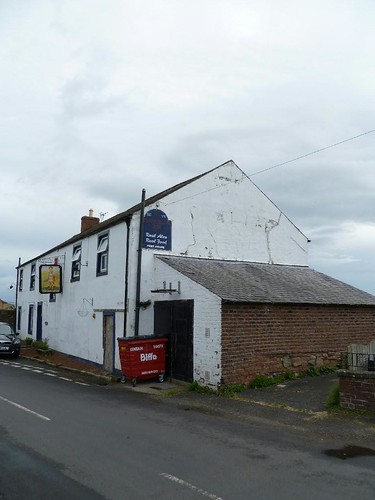Wall Mile 60 [HB 336]
Just after Wall Head, the lane along which we have been walking turns off to the right, but we are going to follow the line of the Wall straight on and through a gate and one of the many benefits of walking Hadrian’s Wall west to east suddenly becomes apparent.

Track on line of Wall heading towards Blaetarn
Here, for the first time, the Wall ceases to coyly peep at us from hedgerows and the major components – or at least their respective remnants – present themselves. The line of the curtain wall itself is represented by a low causeway running across the pasture towards the farm at Bleatarn, whilst a depression to the left marks the course of the ditch and, some way to the right, the earthworks of the Vallum can be made out near the western field boundary. Aerial photography has revealed extensive pre-Roman field systems in this area, the alignments of which the Wall blithely ignores (later agriculture always tends to respect the monument, which is why its course is so obvious across most of the countryside).

Causeway leading to Blaetarn
As we move along our mural causeway towards Bleatarn Farm, it will become apparent that some substantial earthworks, possibly associated with hollow ways and quarries, have enhanced and in part removed the line of the ditch to the north, whilst next to the farmhouse itself, the rather pleasant rush-bedecked tarn which gives it its name is probably also a result of such delvings.
The Trail crosses a lane by means of two gates (through the first you need to look slightly to your left to find the second), and then we are in the fields again. To your right, next to Bleatarn Farm, you will find one of the few portaloos provided along the line of the trail. If the National Trail has failings (it actually has several), one of the most serious is the lack of provision of facilities for walkers. Later we will encounter grumpy notices asking us to refrain from using farm buildings as lavatories, but what we seldom find are such thoughtfully provided toilets as this one at Bleatarn. This subject is by and large avoided in most discussion of the Trail and why this should be is mystifying.

Hollow way on the line of the Wall ditch
Crossing the field, we keep immediately north of the hedgerow, noting how the line of the ditch to our left is used by a green lane. Once we have crossed the next field boundary and are in the second field, we are close to the site of Milecastle 60. Looking back, we can see how we have been walking along the berm (the hedgeline in the next field to the east takes up the line of the curtain wall itself again) and that the green lane has moved up onto the north lip of the ditch, which is now decidedly sodden.
Congratulations – together we have completed twenty Roman miles of the length of Hadrian’s Wall, or exactly one quarter of its original length (but not, please note, one quarter of the length of the National Trail – they are two very different things).
Milecastle 60 (High Strand) [HB 336; haiku]

The site of Milecastle 60
Although Milecastle 60 (High Strand) has never been excavated, the site has provided another altar to Cocidius, only five Roman miles after the last one, hinting at the popularity of this deity on the western side of the Wall.
























You must be logged in to post a comment.